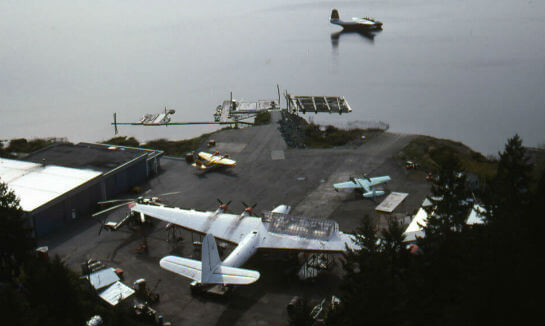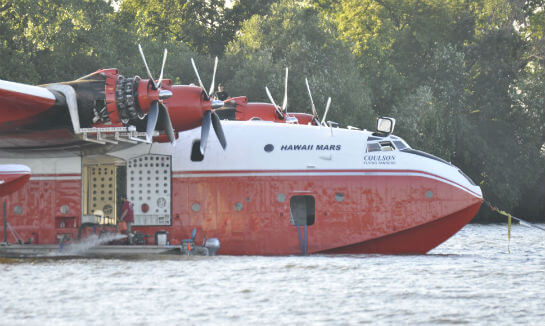Estimated reading time 12 minutes, 8 seconds.
Billed as the world’s largest warbird, Coulson Flying Tankers’ giant red and white Martin Mars flying boat was a star attraction at this year’s EAA AirVenture Oshkosh in Wisconsin in late July.

As the explosion of pyrotechnics on the east side of Wittman Regional Airport’s Runway 18-36 sent smoke rising into the air, the four-engine Hawaii Mars roared towards the airfield in aerial firefighting mode.
After a quick pass over the makeshift “wildfire,” the crew of the 200-foot wingspan Hawaii Mars circled around and then commenced a bomb run on the blaze, which was easily extinguished by the release of 27,276 litres (7,200 U.S. gallons) of water before tens of thousands of EAA aviation enthusiasts.
EAA AirVenture Oshkosh is the largest airshow in the world. For seven days in July the airshow attracted 563,000 people (an increase of nearly one per cent over 2015), and 2,855 showplanes, including 371 warbirds.
The appearance of Hawaii Mars after 50 years in aerial firefighting service was a major coup for AirVenture and an excellent venue for the Coulson Group to stimulate international interest in the sale, lease or future use of the world’s last two Martin Mars aircraft.
In previous years, Hawaii Mars was always on a firefighting contract in late July and couldn’t be released to attend the eastern airshow.
The Mars is flown with a four-man crew, consisting of two pilots and two flight engineers, who manage the aircraft’s four 2,500-horsepower Wright R-3350 Duplex-Cyclone 18-cylinder radial engines.
Coulson also launched the Ultimate Flying Experience this summer–the opportunity for a pilot to receive personalized instruction to fly the giant flying boat for a fee.
The first pilot to sign up for flight instruction was well known aerobatic pilot and aircraft collector Kermit Weeks of Florida. Weeks owns the Fantasy of Flight Museum in Florida, which contains the world’s largest private collection of vintage and veteran aircraft, including a four-engine 1944 Shorts Sunderland that was flown from the U.K. to the 1993 Oshkosh fly-in after a stop in Toronto Harbour.
During his training, Weeks piloted Hawaii Mars over numerous communities on the British Columbia coast and under the guidance of Coulson pilots also landed the giant flying boat in Vancouver Harbour.

So far, Coulson reports that several pilots have signed up for the Ultimate Flying Experience.
The Mars base near Port Alberni, B.C., has long attracted aviation enthusiasts from around the world, but the majority of Oshkosh attendees were unaware that the world’s largest operational flying boat was still flying in British Columbia.
The high cost of mobilizing the aircraft across the continent was partially offset by sponsorship from the EAA and Kermit Weeks, as well as $125 per person VIP tours of the aircraft when it was anchored at the seaplane base. Special guests included actor and pilot Harrison Ford, who is a long-time EAA Young Eagles supporter.
Martin JRM Mars
The Glenn L. Martin Company of Baltimore, Md., built seven Mars flying boats between 1942 and 1947 for the United States Navy as long-range wartime transports that could carry cargo and troops between San Francisco, Hawaii and the Pacific Islands.
The four surviving Mars were retired from U.S. Navy service in 1956 and purchased in 1959 by a consortium of five British Columbia forestry companies–Forest Industries Flying Tankers (FIFT)–for conversion into large capacity water bombers.
The coastal B.C. forest industry lost tens of millions of dollars of commercial timber in wildfires in the late 1950s. The Mars fleet was repurposed as direct attack aircraft that could extinguish wildfires by saturating up to four acres of dense forest at a time.
Sproat Lake in central Vancouver Island became the operational base for Philippine Mars and Hawaii Mars, which attacked hundreds of wildfires over the next 40 years, primarily on the southwest coast of British Columbia.
In 2007, the last remaining FIFT partner, TimberWest, sold the Mars operation to Coulson Air-Crane, a Port Alberni logging company that also operated a fleet of Sikorsky S-61N helicopters on firefighting contracts in the United States and Australia.
Coulson began to actively market the aircraft’s unique firefighting capabilities and won contracts from the B.C. government, the U.S. Forest Service in California (2007 to 2009 inclusive) and Mexico in 2011.
British Columbia terminated its Mars contract at the end of the 2013 fire season; at the same time, Coulson began flying its first land-based Lockheed C-130Q air tanker on an exclusive use contract with the U.S. Forest Service.

The Mars base on Sproat Lake was closed to the public. Philippine Mars was stripped of its red and white paint and repainted in wartime U.S. Navy colours to join the collection of U.S. National Museum of Naval Aviation in Pensacola, Fla., but this transaction remains uncertain.
In 2015, Hawaii Mars was made operational to train Chinese test pilots scheduled to fly the new AVIC TA-600 flying boat and received a 30-day contract to fight wildfires on the B.C. coast after public protest.
Mars mishap
On Friday, July 29, Hawaii Mars suffered an accident at Oshkosh that put it out of action for a couple of days.
“We were out doing a demonstration flight last night and we were scooping a load when we had a low manifold pressure light on the number 4 engine,” wrote Wayne Coulson on the Martin Mars Facebook site. “We had 6,000 gallons on board and aborted the takeoff…(when) we were a mile offshore.”
Inbound to the mooring buoy, the loaded aircraft struck a rock in a shallow portion of Lake Winnebago and started taking on water. Emergency pumps were quickly deployed and a diver discovered two holes in the hull that needed to be patched, each about three inches in diameter.
“We have two divers and team members of EAA to help us on the metal repair and have resolved the engine problem,” Coulson later reported.
He thanked the local fire department for providing emergency pumps, the EAA for its assistance preparing the hull patches, and the Wisconsin Office of Underwater Construction Corporation for providing a three-man dive team to assist with the patching of the Mars.

Hawaii Mars returned safely from its Oshkosh adventure, landing at Sproat Lake on Aug. 2.
Mars for sale
Both Martin Mars aircraft are currently for sale for around $3 million each. Coulson would like to see the aircraft go to a good home and is now entertaining at least four serious offers to buy the aircraft as a result of its Oshkosh appearance, which was widely reported in the international media including CNN in the United States and the Daily Mail in the U.K.
After spending more than 50 years as a working aircraft in Canada, there are many voices saying that at least one Mars should be preserved at a Canadian museum for future generations.
The last time a historically significant B.C. flying boat was put up for sale, aviation enthusiasts lobbied to have the RCMP’s Prince Rupert-based Grumman G-21 Goose preserved at the Canada Aviation and Space Museum in Ottawa. The aircraft was subsequently acquired by the museum in 1995.
In the 1970s, two B.C.-based aviation museums were established in the wake of the controversy that followed Ottawa’s decision to not acquire the world’s last surviving Supermarine Stranraer flying boat, which was built in Montreal and had spent its entire career flying with the RCAF and airlines on the B.C. coast. This rare Canadian-built aircraft was subsequently purchased by the U.K. government in 1970 and is now a star attraction at the Royal Aircraft Museum in Hendon, north of London.








